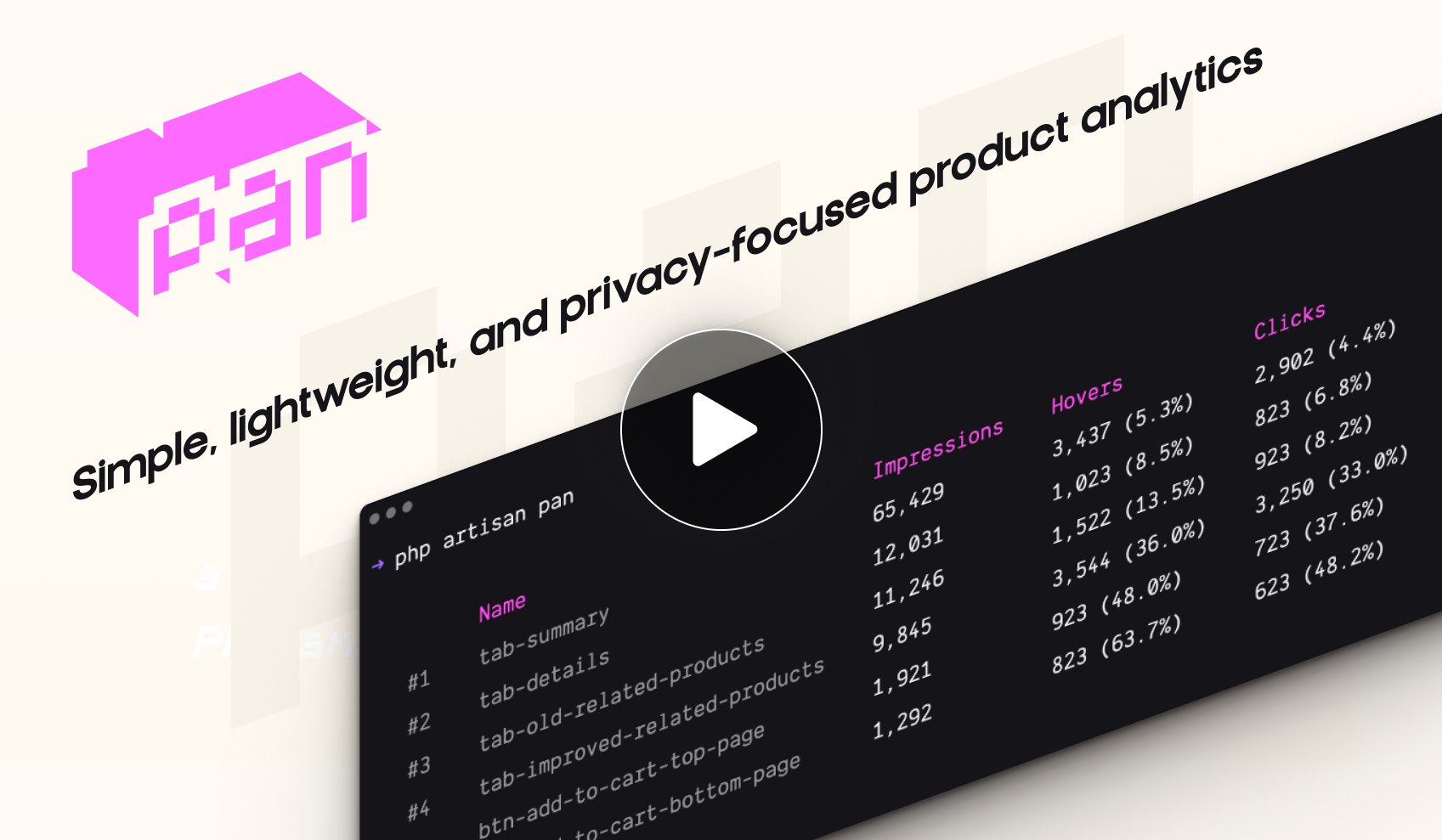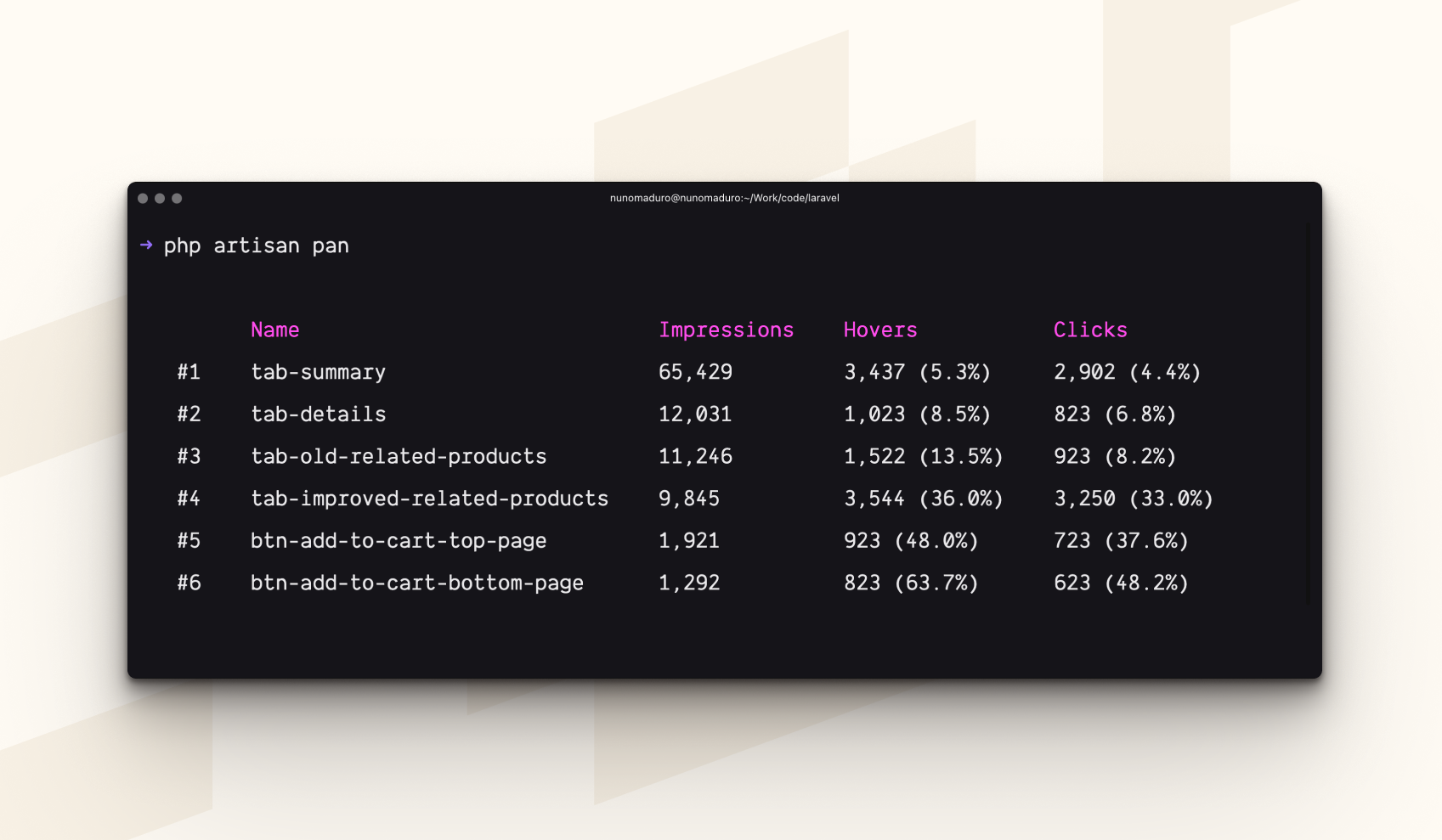Pan is a lightweight and privacy-focused PHP product analytics library. It’s designed as a very simple package that you can install via composer require and start tracking your pages or components with a simple data-pan attribute.
At the time of writing, Pan tracks only the following events: impressions, hovers, and clicks. It does not collect any personal information, such as IP addresses, user agents, or any data that could be used to identify a user.
Use cases:
- you have different tabs within a page with the same URL, and you want to know which one is the most viewed. By adding the
data-panattribute to your tabs, you can track this information. - you have different register buttons in your application, and you want to know which one is the most clicked. By adding the
data-panattribute to your buttons, you can track this information. - you have different "help" pop-hovers in your application, and you want to know which one is the most hovered. By adding the
data-panattribute to your pop-hovers, you can track this information. - and so on...
It works out-of-the-box with your favorite Laravel stack; updating a button color in your "react" won't trigger a new impression, but seeing that same button in a different Inertia page will. Using Livewire? No problem, Pan works seamlessly with it too.
Visualize your analytics is as simple as typing php artisan pan in your terminal. This command will show you a table with the different analytics you've been tracking, and hopefully, you can use this information to improve your application.
Requires PHP 8.3+, and Laravel 11.0+.
You may use Composer to require Pan into your PHP project:
composer require panphp/panAfter, you may install Pan into your Laravel project using the following command:
php artisan install:panFinally, you may start tracking your pages or components adding the data-pan attribute to your HTML elements:
<div>
- <button>Tab 1</button>
+ <button data-pan="tab-1">Tab 1</button>
- <button>Tab 2</button>
+ <button data-pan="tab-2">Tab 2</button>
</div>To visualize your product analytics, you may use the pan Artisan command:
php artisan pan
php artisan pan --filter=tab-profileBy default, Pan tracks all the HTML elements with the data-pan attribute, so bad actors could alter your HTML and create unwanted analytics records in your database. To mitigate this, by default, Pan only allows 50 analytics records to be created.
For extra protection, you may use the PanConfiguration::allowedAnalytics method to whitelist the analytics you want to track. This way, only the analytics you've whitelisted will be stored in your database.
use Pan\PanConfiguration;
public function register(): void
{
PanConfiguration::allowedAnalytics([
'tab-profile',
'tab-settings',
]);
}Alternatively, if you want to allow dynamic analytics, you may use the PanConfiguration::maxAnalytics method and this way at least limit the number of analytics records created:
PanConfiguration::maxAnalytics(10000);Finally, if you want to have unlimited analytics records, you may use the Pan::unlimitedAnalytics method:
PanConfiguration::unlimitedAnalytics();To flush your product analytics, you may use the pan:flush Artisan command:
php artisan pan:flushVia middleware, Pan injects a simple JavaScript library into your HTML pages. This library listens to events like viewed, clicked, or hovered and sends the data to your Laravel application. Note that this library does not collect any personal information; such as IP addresses, user agents, or any information that could be used to identify a user.
Also on the client-side, these events are collected in a very performant way and batched together to reduce the number of requests to your server.
On the server-side, Pan only stores: the analytic name, and a counter of how many times the different events were triggered. Via the pan Artisan command, you may visualize this data, and hopefully use this information to improve your application.
Pan is open-sourced software licensed under the MIT license.




